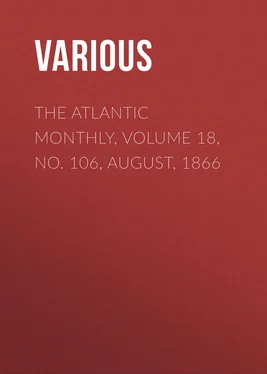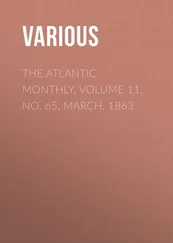Various - The Atlantic Monthly, Volume 18, No. 106, August, 1866
Здесь есть возможность читать онлайн «Various - The Atlantic Monthly, Volume 18, No. 106, August, 1866» — ознакомительный отрывок электронной книги совершенно бесплатно, а после прочтения отрывка купить полную версию. В некоторых случаях можно слушать аудио, скачать через торрент в формате fb2 и присутствует краткое содержание. Жанр: foreign_antique, periodic, foreign_edu, на английском языке. Описание произведения, (предисловие) а так же отзывы посетителей доступны на портале библиотеки ЛибКат.
- Название:The Atlantic Monthly, Volume 18, No. 106, August, 1866
- Автор:
- Жанр:
- Год:неизвестен
- ISBN:нет данных
- Рейтинг книги:3 / 5. Голосов: 1
-
Избранное:Добавить в избранное
- Отзывы:
-
Ваша оценка:
- 60
- 1
- 2
- 3
- 4
- 5
The Atlantic Monthly, Volume 18, No. 106, August, 1866: краткое содержание, описание и аннотация
Предлагаем к чтению аннотацию, описание, краткое содержание или предисловие (зависит от того, что написал сам автор книги «The Atlantic Monthly, Volume 18, No. 106, August, 1866»). Если вы не нашли необходимую информацию о книге — напишите в комментариях, мы постараемся отыскать её.
The Atlantic Monthly, Volume 18, No. 106, August, 1866 — читать онлайн ознакомительный отрывок
Ниже представлен текст книги, разбитый по страницам. Система сохранения места последней прочитанной страницы, позволяет с удобством читать онлайн бесплатно книгу «The Atlantic Monthly, Volume 18, No. 106, August, 1866», без необходимости каждый раз заново искать на чём Вы остановились. Поставьте закладку, и сможете в любой момент перейти на страницу, на которой закончили чтение.
Интервал:
Закладка:
Now the Nephila plumipes possesses at least three pairs of spinners. Of these, two are much larger than the third, which indeed does not appear till they are separated. From the posterior of the two largest pairs seems to proceed the white , and from the anterior the yellow silk, while from the small intermediate pair seem to proceed very fine filaments of a pale-blue color, the use of which is to envelop the prey after it has been seized and killed, being drawn out by the bristles near the tips of the spider's hinder legs. Beside these six papillæ there is, just in front of the anterior pair, a single small papilla on the middle line, the nature and use of which I have not ascertained, though I feel quite sure that no silk comes from it. The large median papilla, just behind the posterior pair, surrounds the termination of the intestines, and through it the excrement is voided, the insect for this purpose turning back the abdomen as she hangs head downward, so that neither the web nor the spinners shall be contaminated. Now it has recently been ascertained that the minute globules with which the circles are studded, and the number of which on a web of average size is estimated at one hundred thousand , do not exist in that form when the viscid lines are first spun by the spider, but as a uniform coating of gum upon a thread; this gum, of itself and according to physical laws, soon exhibits little undulations, and then separates into the globules which have long been observed and supposed to be formed by the spider. The fact of spiders selecting the night for the construction of their webs, the difficulty of making any close observations upon them while so engaged without disturbing them, and the near approximation of the two larger pairs of spinners while the viscid line is slowly drawn out by the hind leg, have hitherto prevented my determining its exact source and manner of formation. If it comes from the anterior pair only, then one and the same organ has the power of evolving a central axis and covering it with viscid gum; and it seems less improbable that the axis is white and formed by the posterior pair, the yellow gum being spread upon it by the anterior pair, which also would then have the power to evolve this same gum at other times as an equally dry, though more elastic thread. But in either case we have only three pairs of spinners and four kinds of silk, the pale-blue fasciculi the dry white , the dry yellow , and the viscid and very elastic silk which is employed only in the circles of the web, and which often does not become yellow till after exposure to the light. Apparently the surest method of investigation will be carefully to destroy one pair of spinners at a time without injuring the others, and then note the effect upon the spinning.
Let us go back now to the sixty spiders left at Mt. Pleasant. A few of these died on the way North, but the majority reached Boston in safety about the 20th of September, 1865; for some time I had observed that they all were becoming more or less emaciated, and relished their food less than at first. Occasionally one died from no apparent cause. The mortality increasing toward the end of the month, and all of them losing both flesh and vigor, I was persuaded to try them with water,—a thing I had thus far declined to do, never having heard of a spider's drinking water, and knowing that our common house species can hardly get it at all. The result was most gratifying: a drop of water upon the tip of a camel's-hair pencil, not only was not avoided, but greedily seized and slowly swallowed, being held between the jaws and the palpi. All of the spiders took it, and some even five or six drops in succession. You will exclaim, "Poor things! what tortures they must have suffered!" I admit that it could not have been pleasant for them to go so long without that which they crave every day, but I cannot believe that creatures whose legs drop off on very slight provocation, and which never show any sign whatever of real pain, suffered very acute pangs even when subjected to what occasions such distress to ourselves.
The few survivors straightway improved in health and spirits; but being now convinced that a moist atmosphere was almost as needful as water to drink, I turned them loose in the north wing of the hot-house in Dr. Gray's Botanical Garden at Cambridge. They all mysteriously disappeared, excepting one, which made a nice web at one end just under the ridge-pole, and for several weeks lived and grew fat upon the flies; but a thorough fumigation of the house with tobacco so shocked her not yet civilized organization that she died.
Her untimely death, however, afforded opportunity for a closer examination of the web itself. The first one she had made was not vertical ; and, following the prevalent ideas as to the precise construction of the spider's web, I had felt somewhat ashamed of my pet, but supposed the next she made would be an improvement. But no, the rebellious insect constantly made them all (for, it should have been said before, this spider seldom uses the same web more than forty-eight hours) after the same manner, and finally I laid it to a depraved idiocrasy, incident to captivity and poor health. But now another and most unexpected feature developed itself; for, on attempting to remove the last web by placing against it a large wire ring, and cutting the guy-lines, I found that this most degenerate spider had not only failed to make her house perpendicular , but had so far departed from the traditions of our ancestors as to have the centre thereof decidedly eccentric, and four times as near the upper as the lower border of the web, so that its upper portion was only a confused array of irregular lines, which it was impossible to secure to the frame. For any accurate observation my web was of no value. But perhaps this was best; for had I then learned what I have since, that our spider utterly ignores every precedent, not only in the position and shape of her web, but also in its minute arrangement , I might have been so affected by her evident bad character and radical proclivities, as to have feared paying her any further attentions,—much more, presenting her to the world.
But in order to understand how these further discoveries were made, we must again go back to the original sixty spiders in my room at Mt. Pleasant, South Carolina.
At the time of their capture, I had observed upon a few of the webs little brown spiders, which I then imagined might be the half-grown young. Six of these were found among the sixty larger spiders, and a moment's examination of their palpi or feelers (Fig. 5) showed that they were males, though even then I could not believe they had reached their maturity; for their bodies were only about one fourth of an inch in length, and weighed only one thirty-second part of a grain, while the females were from an inch to an inch and a quarter in length, and weighed from three to four grains. It was as absurd as if a man weighing one hundred and fifty pounds were joined to a bigger half of eighteen thousand pounds' weight , and I was not fully convinced that these small spiders were really the males of the Nephila plumipes till I had witnessed the impregnation of the eggs of the females by them.

Fig. 5. Palpi, or Feelers.
One morning, in the cell of a large female, I found a cocoon of beautiful yellow silk containing a rounded mass of eggs. Soon the same occurred with other females, and there were fifteen cocoons, which would give about seven thousand spiders . Early in October, just one month after they were laid, the eggs of the first cocoon were broken and disclosed little spiders with rounded yellow bodies and short legs, looking about as little like their parents as could be imagined. The eggs in the other cocoons followed in their order, and now each contained four or five hundred little spiders closely packed.
Читать дальшеИнтервал:
Закладка:
Похожие книги на «The Atlantic Monthly, Volume 18, No. 106, August, 1866»
Представляем Вашему вниманию похожие книги на «The Atlantic Monthly, Volume 18, No. 106, August, 1866» списком для выбора. Мы отобрали схожую по названию и смыслу литературу в надежде предоставить читателям больше вариантов отыскать новые, интересные, ещё непрочитанные произведения.
Обсуждение, отзывы о книге «The Atlantic Monthly, Volume 18, No. 106, August, 1866» и просто собственные мнения читателей. Оставьте ваши комментарии, напишите, что Вы думаете о произведении, его смысле или главных героях. Укажите что конкретно понравилось, а что нет, и почему Вы так считаете.












